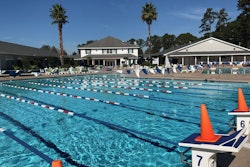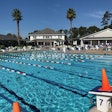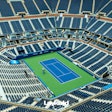
School leadership, students, former NY Knick John Wallace, Bronx Borough President Vanessa Gibson and the project team of developer Pillar Property Management, the architectural team of ESKW/Architects and IMC Architecture, construction manager JV Construction & Consulting, structural engineer CityScape Engineering and general contractor Brisa Builders celebrated a topping-out, a major construction half-way milestone marking the completion of a structural frame, for the Earl Monroe New Renaissance Basketball School (EMNRBS). During the event, the guests, students and the project team members signed the last steel beam to be installed atop the building.
EMNRBS will be the first of its kind in the nation: a purpose-built, specialized high school with an academic curriculum entirely designed around basketball and the many career paths associated with the global game, from broadcast media to sports psychology, law, nutrition, facilities management and venture capital business. EMNRBS is a charter, co-ed, and tuition-free high school. It is located in the 7th School District in the South Bronx, which has the third highest poverty rate and economic need index in New York City.
Design architect ESKW/Architects and executive architect IMC Architecture designed the new five-story building, scheduled to open its doors in 2026. The new school is located at 647 Elton Avenue near the cross section of Third Avenue and East 152nd Street in the Mott Haven section of the South Bronx. The school will operate under a long-term lease from the developer Pillar Property Management.
EMNRBS Board of Trustees Vice Chairman and President & CEO of Tri-State Construction Jack Irushalmi said: “Today we are celebrating the traditional topping out that marks the placement of the last steel beam of the structure and kicks off the final phase of the construction process. This milestone wouldn’t be possible without the vision of our Founder Dan Klores. We are fortunate to have the dedication, hard work, creativity, and expertise of ESKW/Architects and IMC Architecture, JV Construction & Consulting, CityScape Engineering, Brisa Builders and the site team of project managers, superintendents and construction workers. This will be an amazing state-of-the-art school for our incredible students and I am looking forward to celebrating its opening next year.”

"This event is a celebration of more than three years of hard work by an incredibly talented real estate, design and construction team. I extend my gratitude and congratulations to the school, our joint venture partner David Damaghi, the design and construction team and Bank of Hope, which provided a $21 million construction loan for this $35 million project," shared Pillar Property Management Principal Kiumarz Geula.
According to IMC Architecture Principal Jonathan Imani, AIA, “When it is completed in early 2026, this 69,000-square-foot building will feature the latest in athletic and learning technology, including an 8,000-square foot gymnasium, 27 regular and specialty classrooms, a library and media production studio and a dedicated broadcast studio with a green screen.”
“This is a celebration of possibility,” said Kimberly Murphy, AIA, Partner at ESKW/Architects. “We’re honored to be designing a school that will inspire students to pursue careers they may never have imagined. The new building will support a rigorous academic program rooted in the many career paths associated with basketball, from sports journalism and analytics to nutrition, law, business, and design.”
SCHOOL AND PROJECT BACKGROUND
School founder Dan Klores created the New Renaissance Basketball Association (RENS) in 2013 to help historically disadvantaged youth attain college admissions and scholarship awards. Over the years, RENS has supported more than 1,500 student athletes, with 99% of all seniors receiving full college scholarships.
Based on the RENS experience, Klores and NBA icon Earl Monroe decided to open the nation’s first high school entirely designed around careers related to the game of basketball. Planning for the EMNRBS began in late 2019. The school opened its doors two years later in September 2021 in a temporary location at 1617 Parkview Avenue in the Bronx.
School officials tapped Pillar Property Management to join the project team as developer of its permanent location, because the firm specializes in developing educational, housing and public-need facilities in underserved communities. The school's leadership was attracted to Kiumarz Geula’s civic-minded approach to real estate development and his firm’s track record of understanding the needs of local communities when developing projects. The firm has developed approximately two million square feet of real estate.
The 7,000-square-foot development site originally consisted of three adjacent properties, which were combined into one, now owned by a joint venture of Pillar and a former owner. Geula said the site was chosen based on the functional needs of the school as the site’s zoning and layout allowed the development of a building that would meet the school's specific needs. The school signed a 31-year, triple-net lease with the property’s ownership.
PLANNING, ARCHITECTURE AND CONSTRUCTION
ESKW/Architects joined the project as design architect for the EMNRBS. Pillar Property Management retained IMC Architecture as executive architect for the building. Pillar also invited two experienced minority- and women-owned construction firms to join the team: construction manager JV Construction & Consulting and general contractor Brisa Builders, both of which collaborated with the developer on several previous school projects. JV’s Project Manager Claudia Callejas and Superintendent Angel Pina lead the on-site construction team. CityScape Engineering developed the structural system for the building as well as the demolition plan and support of excavation design. The is also performing construction monitoring.
The building's steel structural frame and precast concrete floor planks sit on a foundation of reinforced concrete with spread footings and grade beams. The project’s location at a busy intersection created several logistical and staging challenges for the construction team. “While planning for large structural steel elements delivery and erection, we opted for this complex process to take place on weekends to avoid interrupting individual and commercial weekday traffic. The crane operation will require temporary street closures, which the construction team will keep to a minimum to reduce inconvenience to the neighbors,” shared JV Construction & Consulting President Jovana Villanueva.
“Creating a large, column-free space in the gym area was the main structural design challenge,” explained CityScape Engineering Principal Hadi Djohan, P.E. “We solved it by designing three supersized truss assemblies installed above the gym to support columns and bearing walls for the three levels above the gymnasium. Each truss is one story high and will be hidden inside walls on the third floor, which is immediately above the gym. Bretton Steel fabricated the trusses in Quebec, Canada, in sections up to 391 inches long, each weighing up to 37,000 pounds, to allow for delivery into the construction site to be then assembled into 94-foot-long truss systems. The steel beams making up the trusses are 36 inches deep. An additional challenge was designing the trusses in a manner that allowed for door and window openings in them to meet the interior layout design.”
The project holds a special meaning to Brisa Builders CEO and Managing Member Ericka Keller. “Prior to joining Brisa Builders in 2012, which was established by my parents in 1997, I worked for many years as a charter school principal and public school teacher. The EMNRBS project quintessentially combines my two professional and personal passions: education and construction,” Keller said.
The school will serve up to 440 students in grades 9-12. The five-story building with a cellar will house 24 regular classrooms, averaging 650 square feet each, as well as two specialty science classrooms, an art studio and classrooms dedicated to educational training in fields related to basketball, including weight training and physical therapy. The 8,000-square foot gymnasium will serve as the centerpiece of the building.
ESKW/Architects and IMC Architecture focused on both creating a comfortable and energetic learning environment and ensuring that the school building represents the ideas of openness and belonging to the South Bronx community. The structure will incorporate large, glazed areas of curtain wall into the façade to both allow passersby to visually engage with activities taking place inside and remind students that they are part of a vibrant community. The designers selected exterior materials that are easily recognizable as associated with both traditional school buildings and athletic facilities, such as brick and concrete panels.
Reflecting the basketball focus, the architecture is inspired by the traditional field house design of the early 1900s, which featured an arched entrance. This element is reflected in the design of the schools’ entrance, prominently located on the corner of 152nd Street and Elton Avenue. The angular glazing that will be wrapped around and above the main entrance leading into the lobby is an interpretation of this concept. The architects were also inspired by traditional brick facade designs of American schools from the 1920s and 1930s and incorporated a modern adaptation of it into the current design.
The design concept is focused on well-being and health consciousness, including oversized windows that offer increased amounts of natural light. Similarly, the social interaction aspect of school life is reflected in the dining room and lounge envisioned as a social space and in locating numerous informal social gathering areas on each floor housing classrooms.
The two-story-high glazing of the curtain wall that will wrap around the entrance will help integrate the building into the community. The designers chose this as a way to announce the presence of the school to the area and invite people into the building, both symbolically and literally. The seven-foot-wide interior staircase, which will allow students to access all six levels of the building, will be articulated on the building's exterior through a glazed curtain wall.
The architectural and engineering team faced an interesting challenge of locating a massive gym in a tight, urban location, while ensuring that the building meets the school's programming needs. They achieved this by placing the upper floors above the gym, which is unusual due to structural challenges of building floors above wide-span spaces without columns. ESKW/Architects, IMC Architecture and structural engineers developed an oversized truss structural system that is 12-feet-high with 95-foot-long lower beams. Due to its dimensions, the designers creatively hid the system in the walls and ceilings of the third floor in the area above the gym.
The team chose many unusual design elements and features for the project. One interesting concept is the choice to use different colors of exterior brick masonry to distinguish the building's public and private spaces within. Public places on the lower levels, such as the gym, library and lobby, will have a traditional color, while the exterior of the section housing classroom spaces on the upper floors will have a lighter colored brick. The building's exterior will also use gray panels to indicate the location of the gym and library/media center as well as to break up the massing of the building.
Another design challenge was how to make the facade detail at the entrance visually interesting. According to IMC Project Architect Austin Schlosser, “In order to do this, ESKW/Architects designers incorporated unusual, angled brick walls surrounding the glazing system around the lobby as well as a sloped brick system stepping down toward the glazing. IMC identified a supplier, IG Masonry Support, who helped engineer this system and design and fabricate custom brackets that to support this unusual brick feature.”
The building will have an international aspect, as the windows will be manufactured in Germany and the Netherlands and the structural system above the gym will be fabricated by Bretton Steel based in Quebec, Canada. In addition, the brick bracing system manufacturer, United Kingdom-based IG Masonry Support’s manufacturing facilities are located in Poland, England and Wales.
INTERIORS
As students enter the building, they will encounter the main lobby. The focal point of the 1,300-square-foot space will be a dramatic 16'x9' TV screen wall that broadcasts the school's branding, programming and information on current events and school activities. The lobby will also have a custom reception desk with a quartz counter and a security desk – or welcome desk. As students move through the lobby, they'll find passageways that either lead to the gymnasium or the classrooms on the upper floors. Some of the staff offices that will be located on the ground floor include the principal’s office, community coordinator's office and nurse's office. The lobby will feature lounge furniture and seating and potentially a donor wall.
There will be a large window that looks into the stairs behind the welcome desk. The walls will have wood panels perpendicular to the TV wall that will be visible from the outside for a dramatic effect. The lobby will also feature accent lighting, porcelain ceramic tiles and a gypsum board ceiling with ECT sound-absorbing panels.
The two-story-high glazing that will wrap around the entrance lobby will help integrate the building into the community. The designers chose this as a way to announce the presence of the school to the area and invite people into the building, both symbolically and literally. Since the school might host community events in the gym, the entrance lobby was organized with a floor layout that will allow visitors to proceed directly to the gym, while keeping the rest of the school separated from that pathway for safety reasons. The glow of oversized TV screens and welcoming design of the lobby will be visible through the glazing, showcasing the school’s activities and signaling its openness to the neighborhood. The building will house two main staircases and one elevator.
“As visitors pass the welcome desk, they will proceed into the gymnasium, which will be a full competition-scale athletic facility featuring a central full court and two side courts,” added Schlosser. “It will have telescopic seating for 350 spectators and an additional 40 seats for players, coaches and staff. It will feature six side-swinging, electrical basketball backstops and one digital scoreboard, as well as 300 square feet of support and storage spaces, and an area with broadcast equipment for live-feed broadcasts and taping of games for analysis. The gym will also have a large projection screen on the south end for school meetings and events.”
The gym will feature seven clerestory windows. They will be located 15-feet high on the wall on the north side of the building to allow natural light in but not direct sunlight that would impair the players' vision. The gym will also include a DIN-certified engineered wood floating floor system and drywall with padding in the school's colors on the north and south ends. The ceiling concrete deck and steel beams will be exposed. All lighting throughout the building, including the gym, will be high-efficiency LED fixtures, with the gym featuring oversized pendant fixtures with extra bright, energy-efficient LED lighting elements.
The cellar will house the student dining center and lounge. This multi-functional space with an open floor plan is designed for social gatherings and will be used as a secondary education area for studying after class. It also features a nutritional education center and retail space where guests can purchase school merchandise during games. Although it is a rare feature in urban schools, students will receive fresh and nutritional quality food that's cooked onsite in the adjacent full-service kitchen. The cellar will also house a large weight training room with rubberized athletic flooring that will also be used for physical therapy classes, as well as a dance room with a floating floor system and a recording room that are part of the school's music program.
The dining/commons area in the cellar will feature light gray ceramic tile floors with dark accents and painted drywall. The ceiling will have wood composite panels, with one section wrapping down to cover the wall, and accent light fixtures. The designers also chose to use many indirect lighting fixtures as a wellness element, since indirect lighting provides a better light quality. The serving area will incorporate a 28-foot-long counter that wraps around the corner. The front will be clad in white subway tiles and the top will feature an engineered quartz stone counter.
The second floor will have a partial footprint, because the upper level of the gym occupies a portion of it. This level will house a lounge area that will serve as VIP seating for games and a multi-functional library with a media center and conference room. The executive director's office, which will overlook the gym, and the staff lounge will also be located on this floor. There will be open glazed walls adjacent to the gym so people can look into the gym from the area. The lounge space next to the library/media center and the broadcast studio also will have windows that overlook the gym and the lobby.
The third through fifth floors will primarily house classrooms and will each contain a whiteboard area for studying after class, as well as various offices. On the third floor, students will find seven regular classrooms and one art room, as well as an outdoor terrace for student use. It will also include the academic dean and special education offices and gender-neutral bathrooms featuring full-height stalls and a shared hand washing and sink area. The fourth floor will include 10 classrooms, including chemistry and physics rooms with custom casework and individual lights customized to the particular science needs, as well as the dean of student culture's office.
The fifth floor will also include 10 classrooms and the college career counseling office. A unique feature of the classroom floors is that the lockers in the corridors will be located in bays and won't be doubled on both sides of the hallway to reduce crowding and make traffic flow easier throughout the corridors.
All the hallways throughout the school will feature resilient tile flooring and the lockers will be designed with a custom color pattern based on the school's colors. The classrooms will also feature the same flooring and have varied ceiling heights, with some sections up to 10 feet high, and include indirect light fixtures and acoustic tiles.

































